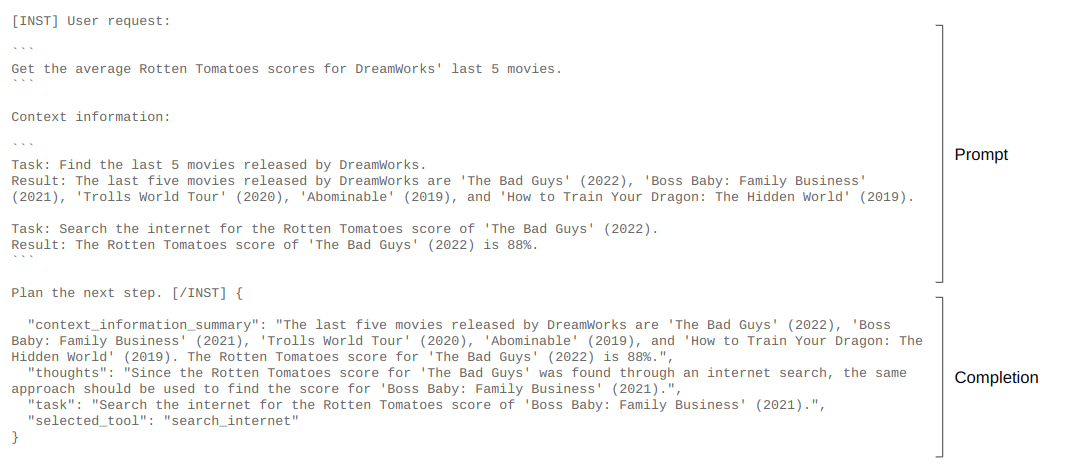I recently experimented with fine-tuning an LLM agent on synthetic trajectories. During fine-tuning, a planner module learns to create a task description for the next step and select an appropriate tool to execute that step. The selected tool is responsible for translating the informal task description into tool-specific executable actions and returning a (summarized) observation to the planner.
Fine-tuning was done with a loss over the full sequence i.e. prompt and completion tokens. Common practice however is to compute the loss over completion tokens only and masking the prompt. This difference is illustrated in the Figures 1 and 2:
Figure 1. Training example with loss over prompt and completion tokens.
Figure 2. Training example with loss over completion tokens only.
Motivation for computing the loss over the full sequence was to learn from previous task-observation pairs available in a prompt, a pattern that might be useful for predicting the next step in an agent trajectory. This is related to Instruction Tuning With Loss Over Instructions, a paper that reports improved downstream tasks performance when applying a loss function to the instruction (= prompt) and completion part of training data.
To investigate if prompt masking has a significant impact on LLM agent planning performance, I fine-tuned two planner models, one with prompt masking and the other without, and evaluated their performance in a simulation environment, with a GPT-4 based planner as reference.
The reported metrics are pass_rate, bad_task_rate and completion_rate (details here):
| series | pass_rate | bad_task_rate | completion_rate |
|---|---|---|---|
| fine-tuned w/ masking | 0.85 ± 0.01 | 0.14 ± 0.01 | 0.98 ± 0.01 |
| fine-tuned w/o masking | 0.88 ± 0.01 | 0.12 ± 0.01 | 0.99 ± 0.01 |
| gpt-4 | 0.90 ± 0.01 | 0.11 ± 0.01 | 0.98 ± 0.01 |
Observations made in the simulation environment have high variance, incl. missing or partial observations with a configurable probability. Therefore, metric statistics (mean and standard error) are calculated from 12 evaluations runs.
Fine-tuning with prompt masking seems to result in decreased planner performance but with only weak support from a statistical significance test: a t-test on the metrics of series fine-tuned w/ masking and fine-tuned w/o masking gives a p-value of 0.10 for pass_rate and 0.22 for bad_task_rate.
Using a p-value of 0.05 as significance threshold, a preliminary conclusion is that prompt masking doesn’t have significant impact on planner performance, at least in the used simulation environment.

